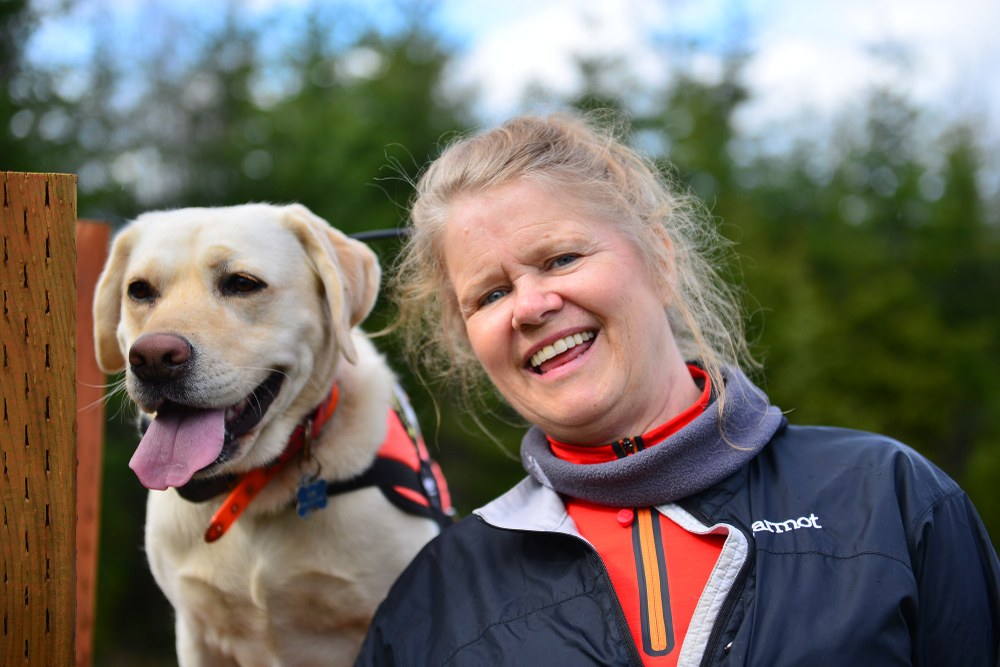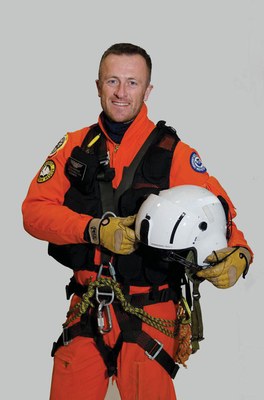
On March 22, 2014, a natural disaster hit the state of Washington in the form of a massive mudslide.
It covered a square mile and engulfed nearly 50 homes in Steelhead Haven, Oso. To me, it seemed like something out of a history book – before land surveillance and building regulations. But to the people of Oso, it was very real. Unlike historical tragedies, they had a major advantage: highly skilled and organized rescue teams.
I had the pleasure of interviewing four of our very own Mountaineer members who helped out during the Oso rescue: Suzanne Elshult and Chris Terpstra of the K9 Search and Rescue Team, and Dave Zulinke and Oyvind Henningsen of the Helicopter Rescue Team. These teams were among the first responders to the mudslide and — like many other specialty rescue teams — made up of entirely of volunteers. All four are members of the Everett Mountain Rescue Unit.
I asked why each of them became rescuers:
Suzanne, Bosse and Keb (search and rescue dogs)
Suzanne has been part of the K9 Search and Rescue Team for over thirteen years. It was an incident that happened more than two decades ago though that changed her life and eventually paved the way for a future in search and rescue missions: She witnessed the death of a close friend as he slipped off a granite rock atop a waterfall, near Yosemite Park. Suzanne describes it as happening in slow motion – an image forever etched in her memory. It left her with a fear of heights that hindered her outdoor and mountaineering adventures for years.
Then, in 2001, the much-publicized 9/11 rescues inspired her to overcome her fear of heights and help with mountain rescue — as her husband Scott was already doing. She adopted Bosse, her now retired yellow Lab rescue dog, and enrolled in Mountaineers scrambling and climbing courses. She was able to spend more time with her husband, save lives, work in the mountains, and conquer her fears.
As Suzanne reflects in her blog on her executive coaching site, “Looking back on it all, I now see, in sharp relief, how that tragic day came to importantly shape myself as a person. For many years it would severely limit me. But later it would allow me to feel the success of stepping into my fear, embracing it and using it to propel myself forward in many aspects of my life.”
Suzanne also has a four-year-old Lab named Keb who started training at two months with Bosse’s help. Keb is certified as both a human remains detection and airscent search dog, known for her “body slam” indications when she finds lost subjects. Keb also trains in avalanche and disaster rescue.
Chris and Ferdie (rescue dog)
Chris’ introduction to mountain rescue came with his desire to get a dog and his conviction that it should be an active, working dog. Both Chris and his wife are involved with K9 Search and Rescue. His current canine partner is Ferdie, a yellow Labrador retriever — like Bosse and Keb. Ferdie specializes in airscent and also trains in avalanche, disaster and human remains detection.
Chris’ interest in the mountains started well before Ferdie. He got involved with a Boy Scout/Mountaineers group when he was 19. Chris is currently a Crisis Manager at Microsoft but he says Search and Rescue came first. His drive to help people and a flexible schedule keep him active on the team.
Dave
In 2004, Dave attended an EMRU (Everett Mountain Rescue Unit) meeting and was impressed with what he learned. He was already a climber so he started training with the Helicopter Rescue Team (HRT) right away. His first mission was on Mt. Dickerman with Scott, Suzanne’s husband. EMRU is a pretty tight-knit group, which Dave really likes. “There’s a lot of fostering self-improvement for the good of the unit,” he says.
Oyvind
Oyvind got involved with EMRU in 2007, but was inspired years before, on Christmas Eve 1996. Skiing with his brother, Oyvind saw a mountain rescue group going up Snoqualmie Pass to help people caught in an avalanche. The rescue group’s selflessness in giving up their holiday to help strangers stayed with him. Through the Mountaineers, Oyvind took Mountaineering Oriented First Aid (MOFA) and a backcountry ski course before finding his way to an EMRU meeting. He eventually served as chair of EMRU and now volunteers with HRT.

Everett Mountain Rescue Unit (EMRU)
The Everett Mountain Rescue Unit started in 1954 with a small group of Mountaineers who organized a rescue mission on Mt. Stickney. Today, with more than 70 active members, EMRU works with the Snohomish County Sheriff's department on search and rescue operations. Many EMRU members also participate in Snohomish County Volunteer Search and Rescue specialty teams such as K9, HRT, 4x4, Horseback, and Swiftwater. I was surprised to learn that these rescues aren’t all in the mountains. Suzanne estimates that 60% of K9 rescue calls now come from urban areas, a big shift from ten years ago when most were wilderness rescues. It doesn’t matter to the rescuers, though. When the pager goes off, it means that someone needs help. Those that are available or on call immediately hop in the car and provide whatever support is needed.
The hero in you
So who becomes a rescuer? According to Suzanne, Chris, Oyvind and Dave, they’re not so different from you and me. As a matter of fact, being a member of The Mountaineers is a great place to start. The Everett Mountain Rescue Unit often recruits from The Mountaineers and recommends that those who want to be part of a mountain rescue team take our Basic Alpine Climbing and Wilderness First Aid courses.
I commented that I probably wouldn’t be the top choice for a rescue team because of my small stature. However, Suzanne says they look for all kinds of skills and backgrounds and pointed out that she’s not much taller than me. A good team is a balanced one. The traits of a good rescuer include risk assessment skills, leadership, navigation, camaraderie, and a flexible schedule. Oyvind said good humor is another essential quality. Rescuers spend a lot of time working closely in high-stress situations - like a climbing team, but with an important difference. By the time a rescue team is called, something has already gone wrong. It takes a level head, good judgment and training to figure out the best ways to help.
If you think you might be a good candidate, don’t worry; you won’t have to come pre-trained. The individual SAR teams train together, sometimes as much as 15 hours a week. A good place to start is the Everett Mountain Rescue Unit meetings, held at 7pm the first Monday of each month in Taylor's Landing in Snohomish. They’re open to anyone who wants to learn more.
If you (and your dog) would like to find out more about how to get involved in K9 Search and Rescue, send an email to searchdogs@scvsar.org. To donate, send a check to SCVSAR, Attn: K9 Team, 5506 Machias Rd., Snohomish, WA 98290. Or click on the Paypal link at www.scvsar.org and specify that you want your donation to go to the K9 team.
The Snohomish County Search and Rescue K9 unit is funded entirely by donations and the Helicopter Rescue Team (HRT) is cooperatively funded by donations and government funds. To learn more or make a donation to HRT, go to helicopterrescue.org and click on 'Get Involved.'
 Suzanne Gerber
Suzanne Gerber